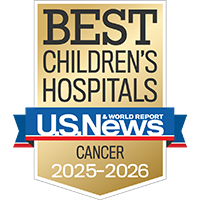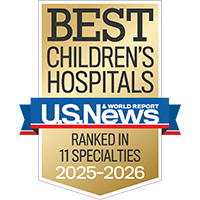Saving future lives
500+ UCSF investigators are researching cures for hundreds of childhood and adult diseases.


Leukemia is an umbrella term for certain cancers of the blood. These disorders develop in the blood-forming tissues of the bone marrow and usually affect white blood cells (key players in fighting infection). Leukemia is the most common form of childhood cancer, accounting for about 1 in 3 cases of cancer in kids. Although leukemia can occur at any age, it is most often diagnosed in children between 2 and 6 years old. Newer treatments have greatly improved the outlook for children with leukemia: Of those with the most common type, 90% survive and go on to have healthy lives.
At UCSF Benioff Children's Hospitals, we provide compassionate, leading-edge care for children of all ages with all types of leukemia. Our world-renowned Pediatric Blood Cancer Program is tailored to the needs of children, with kid-friendly facilities and a team of doctors, nurses and social workers who all specialize in pediatric care. We provide every type of treatment available for pediatric leukemias and are a nationally recognized center of excellence for treating juvenile myelomonocytic leukemia (JMML). Our experts are also active in research to design even more effective therapies. Patients may have opportunities to participate in clinical trials of promising leukemia treatments. Learn more about the process and potential benefits of participating in a clinical trial.

Top 10 in the nation and best in Northern California for cancer care

Ranked among the nation's best in 11 specialties

Accredited by the Foundation for Accreditation of Cellular Therapy
Various tests are used to support the process of diagnosing leukemia. Your child's doctor will choose tests according to your child's medical history, symptoms and risk factors. Frequently used tests include:
If these tests indicate your child has leukemia, we will do additional testing of the blood, bone marrow and CSF samples to determine the type of leukemia and learn more about the genetic makeup of the cancer cells. That information helps guide treatment decisions. The doctor may also order imaging tests, such as a CT scan, MRI scan or ultrasound, to get a better idea of the extent of the disease.
We have much to learn about the causes of leukemia. We do know, however, that it occurs when changes in DNA — which happen for unknown reasons — affect white blood cells, causing them to grow uncontrollably. These abnormal cells can't fight infection properly, and their profusion crowds out other types of blood cells that the body needs. Why those genetic changes happen in the first place is still not fully understood.
Several factors increase a child's risk for leukemia, including:
Also called lymphoblastic or lymphoid leukemia, ALL is the most common childhood leukemia, accounting for about 75 to 80% of cases. In ALL, the bone marrow makes too many of the white blood cells called lymphocytes. They don't mature correctly, making them less effective infection fighters. Also, their abundance leaves less space for red blood cells and platelets, which the body needs. This type of leukemia can progress quickly.
Also called acute myelogenous leukemia, AML accounts for about 20% of childhood leukemias. AML affects myeloid cells (a type of white blood cell), preventing them from maturing correctly. The immature cells can't fight infection properly and can build up in the bone marrow and blood so there's less room for healthy blood cells. Children with certain genetic syndromes, including Fanconi anemia, Bloom syndrome, Kostmann syndrome and Down syndrome, have an elevated risk of developing AML.
CML is a form of myeloid leukemia that progresses slowly and is rare in children. It may develop over a period of months or years.
JMML is rare. It occurs most often in children who are around 2 years old and is more common in boys than girls. JMML causes overproduction of two types of white blood cells that can then crowd out healthy cells in the bone marrow and other parts of the body. This can result in swelling of the liver, spleen and lymph nodes, and outward signs may include paleness, fever and a rash.
The specific signs depend on the type of leukemia and where the abnormal cells accumulate in the body. In acute leukemias, symptoms may develop rapidly, over a matter of weeks. Possible leukemia symptoms, which may be mistaken for flu or other common illnesses, include:
Treatments depend on the type and severity of the leukemia. The following are the most commonly used approaches.
Chemotherapy refers to drugs that kill cancer cells. These drugs may be taken orally (as pills) or administered intravenously (into a vein). The drug choice depends on the specific leukemia being treated. For ALL, the chemo drugs may be injected into the CSF of the spine, an approach known as intrathecal chemotherapy.
Radiation therapy uses high-energy radioactive waves or particles to kill cancer cells and shrink tumors. It's similar to getting an X-ray but the radiation dose is much larger. Radiation therapy isn't typically used to treat childhood leukemias, though it may be used when ALL has spread to the brain, spinal cord or testicles. It also may be used as part of preparing patients for a stem cell transplant.
A bone marrow transplant (BMT), also called a stem cell transplant, replaces the abnormal stem cells (bone marrow cells that form blood cells) with new healthy ones. The first step in the transplant process is administering high doses of chemotherapy, sometimes with radiation, to destroy all the diseased bone marrow cells. The child then receives an IV infusion of stem cells from a matched donor. This donor may be a close relative or a stranger. The key is that certain proteins on the surface of the donor's stem cells are compatible with your child's. This type of transplant, from a matched donor, is called an allogeneic transplant.
Immunotherapy is designed to stimulate or restore the immune system's ability to fight cancer. Using substances produced by the body or made in a laboratory, these drugs can boost, direct or reestablish the patient's natural defenses against disease. We offer a type of immunotherapy called CAR T-cell therapy for childhood ALL that doesn't respond to standard treatment or comes back after treatment.
Targeted therapies are drugs that home in on the parts of a cancer cell that help it grow or spread. This can be a way to get at the cancer while minimizing harm to healthy tissues. Targeted therapies are effective at controlling CML, though they won't necessarily cure it. They may also be used to treat some types of ALL.
UCSF Benioff Children's Hospitals medical specialists have reviewed this information. It is for educational purposes only and is not intended to replace the advice of your child's doctor or other health care provider. We encourage you to discuss any questions or concerns you may have with your child's provider.
Inotuzumab Ozogamicin and Post-Induction Chemotherapy in Treating Patients With High-Risk B-ALL...
Improvement in 5-year disease-free survival (DFS) with modified Berlin-Frankfurt-Münster (mBFM) chemotherapy without delayed intensification (DI) part 2 but with inotuzumab ozogamicin, versus full mBFM chemotherapy backbone includ...
Recruiting
More about this studyInotuzumab Ozogamicin and Post-Induction Chemotherapy in Treating Patients With High-Risk B-ALL...
Improvement in 5-year disease-free survival (DFS) with modified Berlin-Frankfurt-Münster (mBFM) chemotherapy without delayed intensification (DI) part 2 but with inotuzumab ozogamicin, versus full mBFM chemotherapy backbone includ...
Recruiting
More about this studyA Study to Compare Standard Chemotherapy to Therapy With CPX-351 and/or Gilteritinib for Patien...
The Kaplan-Meier method will be used to estimate 3-year EFS, defined as the time from study entry until induction failure, relapse, secondary malignancy, or death.
Recruiting
More about this studyA Study to Learn More About the Health of Persons With Down Syndrome After Treatment for Acute ...
Summary statistics will be used to characterize the study populations on CHC outcomes. Quantitative data (number of comorbidities) will be summarized using descriptive statistics and correlational techniques. Will use pooled logis...
Recruiting
More about this studyA Study to Compare Standard Chemotherapy to Therapy With CPX-351 and/or Gilteritinib for Patien...
The Kaplan-Meier method will be used to estimate 3-year EFS, defined as the time from study entry until induction failure, relapse, secondary malignancy, or death.
Recruiting
More about this studyThe Pediatric Acute Leukemia (PedAL) Screening Trial - A Study to Test Bone Marrow and Blood in...
The proportion will be calculated as the percent of eligible patients who are identified to have an a priori specified genomic or immunophenotypic target and who enroll on at least one of the sub-trials. The corresponding confiden...
Recruiting
More about this studyThe Pediatric Acute Leukemia (PedAL) Screening Trial - A Study to Test Bone Marrow and Blood in...
The proportion will be calculated as the percent of eligible patients who are identified to have an a priori specified genomic or immunophenotypic target and who enroll on at least one of the sub-trials. The corresponding confiden...
Recruiting
More about this studyStudying the Effect of Levocarnitine in Protecting the Liver From Chemotherapy for Leukemia or ...
For patients assigned to arms A and B, the investigators will separately estimate the proportion of patients who experience conjugated hyperbilirubinemia > 3mg/dL during induction chemotherapy by arm along with corresponding 95% c...
Recruiting
More about this studyStudying the Effect of Levocarnitine in Protecting the Liver From Chemotherapy for Leukemia or ...
For patients assigned to arms A and B, the investigators will separately estimate the proportion of patients who experience conjugated hyperbilirubinemia > 3mg/dL during induction chemotherapy by arm along with corresponding 95% c...
Recruiting
More about this studyInotuzumab Ozogamicin in Treating Younger Patients With B-Lymphoblastic Lymphoma or Relapsed or...
The response rate will be estimated using the proportion of eligible/evaluable patients with CR/CRi response. A one-sided lower 95% Agresti-Coull confidence limit will be calculated.
Recruiting
More about this studySaving future lives
